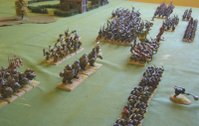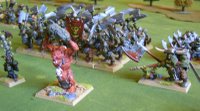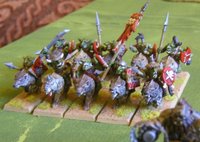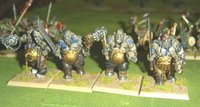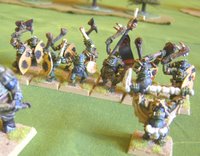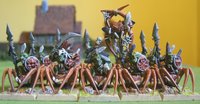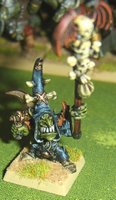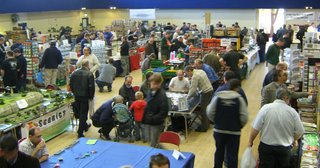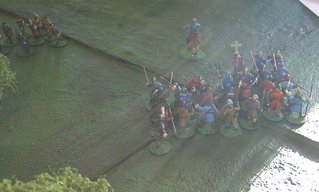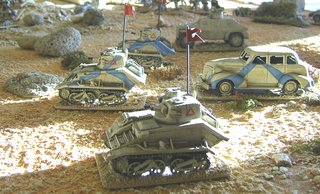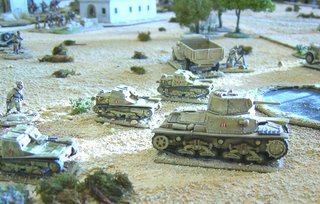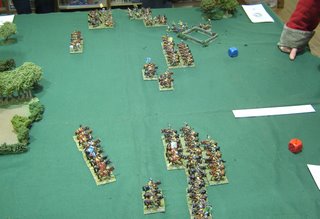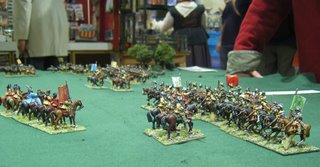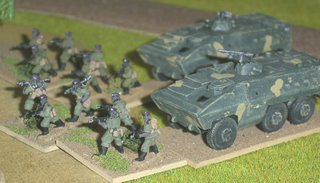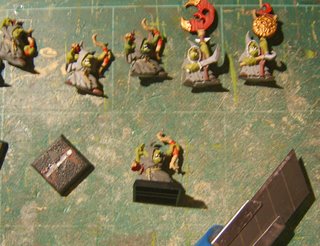My xmas present to any readers out there; a set of rules I originally developed for a godson with an interest in toy soldiers. The idea of these rules is that they be really simple, whilst having some degree of tactical complexity and a command structure. As an introduction to gaming with figures I hope they sufficed, and they can easily be used as a simple club game or whatever for any period from the 1930's onwards.
Basic Rules
Measurements
All measurements are in Imperial Inches, this is simply because the centimetre is too small to be a useful wargame measure. If you prefer the centimetre, simply convert all measurements by a factor of 2.5.
Scale
Figure scale is by default 1:72nd scale or 20mm. This is based on the likely case that a couple of boxfuls of plastic model soldiers are used to play. Of course there is nothing to stop more polished models or different scales being used. There is no need to revise measurements for use with 15mm figures. With 6-12mm figures you may wish to half all measurements; with 28mm or bigger you may wish to double them.
Equipment needed
Rulers or tape measures marked in inches, at least 12 inches long
At least a half dozen six sided dice
a playing area no less than three feet square
a selection of scenery or markers to show it by proxy
two forces of figures typically 20 or more a side
pencil and paper
UnitsUnits are formed of standard sizes at the start of the game:
Squads are five figures strong
Machine gun teams are two figures strong
Mortar teams are two figures strong
Commands are two figures strong
Vehicles are always bought as single models
Units must stay together, no more than 1 inch between each figure in the unit.
As a unit takes fire it will remove figures. This does not reflect outright casualties, but does show the state of the unit (its' morale; for younger players figures removed are stunned or pinned down and may well recover later in the game). When a unit is reduced to no figures at all however, it is permanently out of the game (it is destroyed).
ForcesA force, or army, is formed of any number of units adding up to a points value agreed by both sides (see
points values below).
Starting deploymentOnce terrain has been laid out on the table, each player will roll a D6, the highest score may chose his side for deployment. The opposing player deploys one unit upto 6 inches into the table (unless he has trenches to deploy, see
Trenches, etc in the advanced rules). Then the first player deploys one unit and they continue this way, alternating deployments, until all units are on table. There is no hidden movement.
Sequence of play1: both players roll a D6 for initiative, highest score may elect to go first or second.
2: first player to activate a unit selects one of his units and attempts to control it (see below). If successfull it may then move and or fire in any order.
3: the second player now takes their turn; which must include moving any troops not in cover who have taken casualties as noted under
morale below.
4: the first player now takes an action including compulsory moves and the game continues.
Control of forcesOnce a unit is selected the player must roll a D6 to activate it, to activate a unit you must score a 3+ on a D6. You may add one to your roll if a commander is within 6 inches of the unit. A roll of 1 is always a fail. Failed units may do nothing.
Once a unit passes the test if may move and /or fire in any order, so long as each action is done only once whilst activated. Once done, the turn moves to the opposing player; as it also does when a unit fails.
A unit which is attempting to activate twice in a row (or more frequently even) must score a 4+ to activate. It is perfectly acceptable for the same unit to repeatedly activate, but this is tiring.
As noted under
morale below. instead of activating a healthy unit, a player may use his turn to try to rally a retreating or pinned unit. This is all that may be dne in his turn if the player chooses to do this.
MovementInfantry move the roll of a D6 plus 3 inches (D6+3")
This is reduced if moving through cover as D6 inches
Vehicles move the stated distances on their statlines (see
points values below).
Cover is anything which is placed on the flat table to block lines of sight, for example areas of trees, counting as a wood, lines of hedges or walls, buildings and so on. Hills and buildings blockline of sight entirely to troops behind them, but otherwise units in cover are considered visible.
Infantry fireWhen an infantry unit declares a target it wishes to fire at, measure the distance to the target, a unit may fire if any part of it is within the following distance(s) of the target unit:
- Infantry...................................12 inches
- Machine gun teams..............24 inches
- Mortar teams*.......................36 inches
*Mortars may fire at targets out of line of sight of themselves, so long as any friendly unit on the table can draw a line of sight to the target.
Units roll the specified number of dice to hit for only those figures in range of the target:
- All five figures: 3 D6 needing 6+ to hit
- 3 or 4 figures: 2D6 needing 6+ to hit
- 1 or 2 figures: 1D6 needing 6+ to hit
- Machine gun: 3D6 needing 5+ to hit
- Mortar*: 4D6 needing 6+ to hit
*Mortars roll only 2D6 if they themselves cannot draw a direct line of sight to the target.
The firer loses one D6 if the target is in soft cover
The firer loses two D6 if the target is in hard cover
Soft cover is trees, bushes, hedges, fences, ditches and similar
Hard cover is walls, houses, boulders, trenches and similar
Mortars are mot effected by soft cover
Each succesful roll removes one figure from the target unit and causes it to either retreat or become pinned (see
morale below.)
MoraleWhen a unit suffers the loss of any figures it will either retreat or become pinned down:
Troops with casualties in contact with or on an area of cover will become pinned. Lay the figures down (or mark with a yellow counter)
Troops with casualties who are not in or on an area of cover, will retreat away from their nearest enemies, towards cover until they reach cover, upon which point they become pinned. Face the figures away from enemies (and/or mark with a red counter)
Whenever a player has the chance to activate a unit he must first retreat all units with casualties which are not pinned down. Retreaters move 1D6+6, to a maximum of 9 Inches.
Instead of activating a unit, the player may choose to rally a unit. In which case he must roll more than the number of casualties the unit has lost on a D6 (e.g. ifthe unit has lost 2 figures the roll must be a three or higher). Gun and mortar crews, and commanders always need to roll a four or higher, due to their smaller initial numbers. If a unit attempts to rally within 6 inches of a commander it adds one to the dice roll, though an unmodified result of one is still a fail.
If the unit is rallied it is returned to full strength and removes any markers. It may make a normal move so long as it does not advance closer to any enemy this turn; and it may fire.
If the unit fails its' test it must retreat or remain pinned as normal, other retreating units are moved and the players turn end. In either case all retreating units that can't take a test that turn must move (until they can become pinned) before play reverts to the other player.
Winners and LosersWhen a player finds all his infantry Squads to be either Retreating, Pinned or Destroyed after an opponents turn they are permitted one attempt to rally a single unit. If this fails they are defeated immediately. If vehicles are being used, a player is defeated when all cannon armed vehicles have been destroyed or have left the field of play.
Advanced Rules
Vehicle Movement Vehicle movement is listed on the statline for each type; for example wheeled vehicles normally move upto 2D6+6 inches. Vehicles move half speed in soft cover, and always roll a separate D6, a roll of 1 indicating they have become stuck, and may no longer move. No vehicles except Medium and Heavy tanks may move through hard cover, and they are at half speed and get stuck on a D6 roll of 1 or 2, if they do.
Vehicles always roll an extra D6 when their entire move is on roads.
Vehicles need never move their entire allowed distance.
'Vehicle' fireWeapons other than infantry firearms, mortars and machine guns are considered cannons. Each has a different range and uses a different number of D6 to attack:
(Weapon; Range; Dice vs Infantry; Dice Vs Vehicles)
Light Cannon; 36 inch; inf=3; veh=2
Medium Cannon; 48 inch; inf =4; veh =3
Heavy Cannon; 60 inch; inf=5; veh=4
Bazooka; 6 inch; inf=3; veh=4
When firing against infantry, each dice needs a 5+ to hit
When firing against vehicles each dice needs to roll equal to or over the armour value of the vehicle (for example a light tank has an armour value of 4) on the dice. If the dice result in 1 hit, then the vihicle is damaged, and loses 1 fire dice on future turns. Mark it with a yellow counter. Damage is cumulative, each turn damage is done the vehicle adds a counter and loses a dice. If the vehicle is reduced to no dice against any target type, OR if it suffers two hits in the SAME turn; it is destroyed.
Vehicles never gain cover benefit, except if hull down; this means the vehicle is only partly visible to the firer behind solid cover, such as a building or hill ridge. In such cases add +1 to the vehicles armour, to a maximum of 6.
Vehicles fired on by a shooter who is entirely behind the back of the vehicle and able to shoot at the rear of it, lose -1 from their armour, to a minimum of 2.
Vehicle MoraleVehicles never take morale tests.
ArtilleryArtillery may fire at targets out of line of sight of themselves, so long as any friendly unit on the table can draw a line of sight to the target; as with Mortars.
Artillery may move or fire in a turn, not both, but so long as it goes first, artillery may fire(not move), and then another unit on the players side may attempt to activate. This is the only way two units may take an action in one turn.
Light artillery may fire upto 48 inches and fires with 6 dice versus infantry only
Heavy artillery fires upto 72 inches and fires with 8 dice versus infantry, and 4 versus vehicles at upto 36 inches only.
All dice against infantry need 6+to hit, roll against vehicle armour as normal
The firer loses 2D6 if they themselves cannot draw a direct line of sight to the target.
The firer loses one D6 if the target is in soft cover
The firer loses two D6 if the target is in hard cover
MinfieldsAre laid in secret at the start of the game upto halfway accross the board from the buyers starting edge, they must be marked by a numbered counter - three for every real minefield; The owner writes down which of the sites is an actual minfield on a piece of paper (e.g. 'no.2 of minefields 1 to 3' or similar). Whenever the other player moves within 6 inches of a minefield counter it is removed from play unless it is a real minefield. If it is real it inflicts 4 D6 of damage to any unit or vehicle needing 6+ to hit infantry, and armour -1 against vehicles.
Once discovered a minefield stays in play and any unit straying within 6 inches of the marker is hit in the same way as noted above.
Cannons and Artillery may fire on an identified minefield as if it were infantry. If they score two or more hits the minefield is destroyed and removed from play.
Trenches, etcTrenches, foxholes and so on are dug in terrain, troops in these features gain the benefits of hard cover even if placed in open ground. These terrain features if bought are placed by the owner after normal terrain is set up. Foxholes can give cover to upto 5 figures, trench sections (which may be joined together) upto 20. A player who buys trenches may set them up upto halfway across the table from their starting edge in any position they like, and may choose to deploy infantry to them.
Point ValuesFor a balanced game forces of similar values should be picked, a good small game without many models would be of 100 points per side, a large game with a number of vehicles would be of 500 points or more. Note that where one side is in defense of good ground with trenches, buildings to fight in, minefields and so on it should have only about two thirds the points of the attacker.
Infantry
- Infantry squads = 5 points
- Machine gun teams = 8 points
- Mortar Teams = 12 points
- Command squads = 10 points
- Bazooka upgrade (replaces on normal infantry man in a squad) + 10 points
Vehicles
- Truck (Move 2D6+6; No gun; Armour 2; carry upto 12 figures) = 10 points
- Jeep (Move 2D6+6; Machine gun; Armour 2; Carry upto 5 figures) = 20 points
- Personnel carrier (Move D6+6; Machine gun; Armour 3; Carry upto 10 figures) = 30 points
- Armoured Car (Move 2D6+4; Light Cannon; Armour 3) = 40 points
- Light tank (Move D6+6; Light Cannon; Armour 4) = 50 points
- Infantry fighting vehicle (Move D6+6; Light cannon; Armour 4; Carry upto 7 figures) = 60 points
- Medium tank (Move D6+4; Medium Cannon; Armour 5) = 80 points
- Light motor artillery (Move D6+4; Light artillery; Armour 4)= 90 points
- Heavy Tank (Move D6+2; Heavy Cannon; Armour 6) = 120 points
- Heavy Motor artillery (Move D6+4; Heavy artillery; Armour 4) = 140 points
Towed guns
- Anti-aircraft guns (Move D6; Light cannon x 2; Armour 3) = 60 points
- Anti-tank cannon (Move D6+2; Medium gun; Armour 3) = 60 points
- Super anti-tank cannon (Move D6; Heavy Gun; Armour 3) = 80 points
- Light Artillery (Move D6; Light artillery; Armour 3) = 50 points
- Heavy Artillery (Move D6-2; Heavy artillery; Armour 3) = 100 points
Minefields and trenches
- Minefields = 100 points
- Foxholes (for upto 5 figures) = 5 points
- Trench section (Upto 12 inches long; for upto 20 figures) = 15 points
- Emplacement (for one vehicle or towed gun; gives hull down cover) = 10 points


